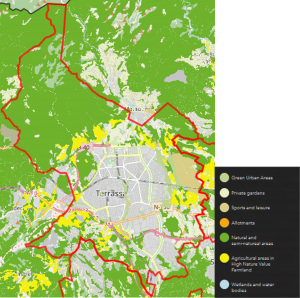 News
News
GMG collaborates in a study on the connectivity of large European cities with their natural environment
The INTERFASE research group of the Department of Geography of the Autonomous University, within the framework of a European project of the European Environment Agency (AEMA), established some indicators to characterize the green infrastructure of the European cities of of 100,000 inhabitants and its peri-urban area. Of the 37 Spanish localities analysed, 15 were considered green but, as the main researcher of the project, Jaume Fons, has stated in different media, these did not have the connectivity, distribution or accessibility of their green infrastructures. All cities have been classified into different groups based on the results. As an example, Terrassa would be considered a forest city due to the presence of the Natural Park of Sant Llorenç del Munt and Serra de l’Obac. Other cities included in this group would be Mallorca, Vitoria or Santiago de Compostela, as they also have natural spaces that are part of their municipal area. Other cities such as Sabadell, Mataró, Bilbao, Pamplona, Gijón and Santander are considered cities with green suburbs. Later, this study was extended to other urban areas (cities of more than 50,000 inhabitants) and detailed its content by classifying the green infrastructure of the cities in the following elements: urban green areas, private gardens, tree cover, orchards, natural areas and farmland of high natural value. GMG has collaborated in the present study in two ways: mapping each of the aforementioned categories for each European functional area and quantifying the surface of each of the categories of green infrastructure. Thus, for example, the functional area of Barcelona recognized at European level and which includes Terrassa and other neighboring municipalities, has the following distribution: urban green areas -Green Urban Areas- (1.5%), private gardens -Private gardens- (6.2%), sport and leisure -Sports and leisure- (2.2%), gardens -Allotments- (0.2%), natural and semi-natural areas -Natural and semi-natural areas- (73, 3%), farmland of high natural value and wetlands – Wetlands and water bodies – (1.6%). Based on this information, the percentage of green infrastructure at 100, 300 and 1,000 meters from schools and hospitals was also studied. As new series of data become available, comparative studies can be carried out to see what the evolution of the green infrastructure of the functional European urban areas is.
